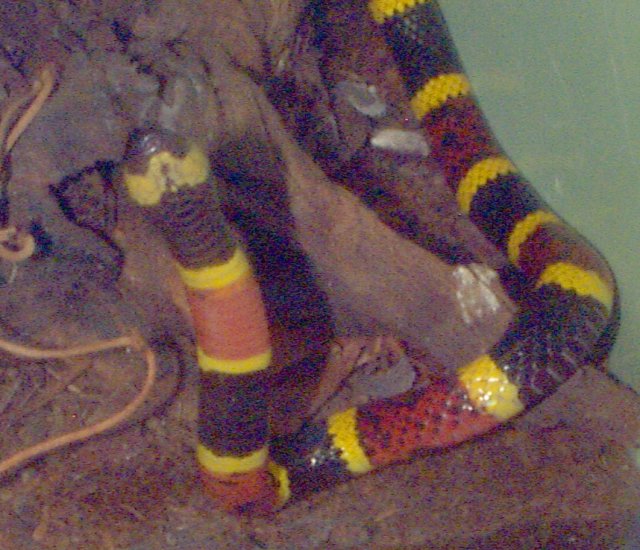Coral Snakes
SPECIFIC INFORMATION
- Scientific Name: Micrurus fulvius tenere
- Range: Southeastern United States and into Mexico
- Habitat: Ranging from wet rocky areas to wet grassy and forested areas
- Status: Not Threatened
- Diet in the Wild: Carnivorous Diet of small snakes, lizards, and amphibians
- Diet in the Zoo: Carnivorous Diet
- Location in Zoo: Herpetarium
The Snake has vibrant colors to ward off would be predators. The Coral Snake is the only venomous snake in North America to hatch its young from eggs. In the case of self-defense, the snake has very potent venom strong enough to kill a man. But because it is an elapid and must hold on tight to deliver its venom, it is less likely to cause a fatal wound. When the snake is disturbed, it lays its head out of sight, rattles its flattened out elevated tail, and creates a popping sound with its vent lining. One must be careful to watch carefully for the bright colors of the coral snake. There are a few species of snakes that mimic the coral snakes pattern hoping that prey will mistake them for the Coral Snake. Some of these common mimics include:
-
Milk Snakes -
Corn Snakes -
And a multitude of others
I have encountered a coral snake in the wild and was at first drawn to it for its beautiful colors, but soon realized what a dangerous animal it was. I left the scene imediately hoping it would not follow.
Snakes are not hostile creatures and with a little bit of care, we can all admire even the most dangerous creatures without any worries. I hope that you have the opportunity to see a coral snake at a local zoo where you can admire it in safety.
Bayou Bob's Rattlesnake Ranch
Publishing company Inc. : Racine, Wisconson,1956.
World Book, Inc.: Chicago, 1990.
one of the most comprehensive animal sites on the web!
Page Author: Ralph Bradley
This webpage was written entirely by hand using a text editor
 WhoZoo Home
WhoZoo Home
Animal Index

